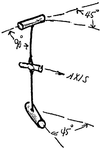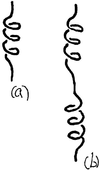The efficiency of propulsion by a rotating flagellum
- PMID: 9326605
- PMCID: PMC23452
- DOI: 10.1073/pnas.94.21.11307
The efficiency of propulsion by a rotating flagellum
Abstract
At very low Reynolds number, the regime in which fluid dynamics is governed by Stokes equations, a helix that translates along its axis under an external force but without an external torque will necessarily rotate. By the linearity of the Stokes equations, the same helix that is caused to rotate due to an external torque will necessarily translate. This is the physics that underlies the mechanism of flagellar propulsion employed by many microorganisms. Here, I examine the linear relationships between forces and torques and translational and angular velocities of helical objects to understand the nature of flagellar propulsion.
Figures





References
-
- Purcell E M. Am J Phys. 1977;45:3–11.
-
- Childress S. Mechanics of Swimming and Flying. New York: Cambridge Univ. Press; 1981. pp. 42–50.
-
- Ludwig W. Z Vergl Physiol. 1930;13:397–504.
-
- Chwang A T, Wu T Y. J Fluid Mech. 1976;75:677–689.
-
- Lighthill M J. SIAM Rev. 1976;8:161–230.
MeSH terms
LinkOut - more resources
Full Text Sources
Other Literature Sources

